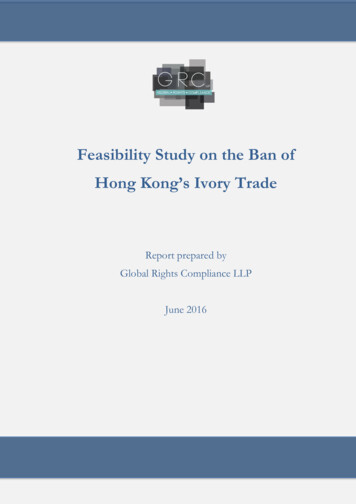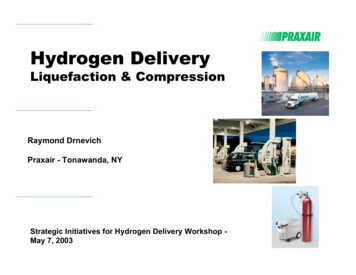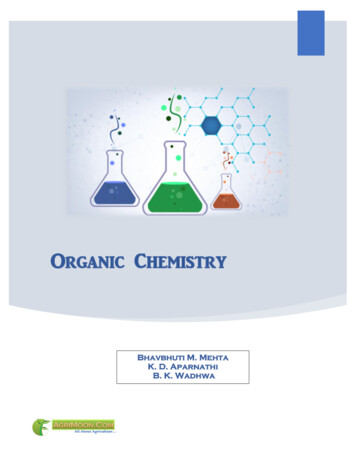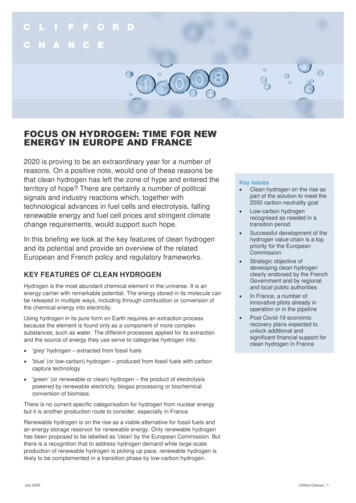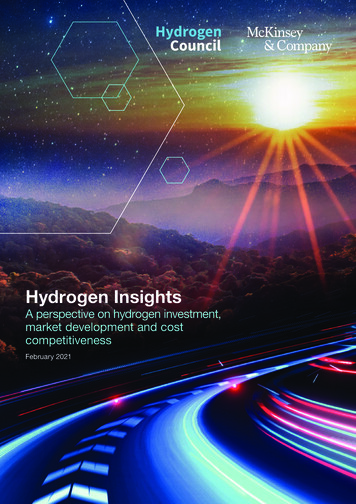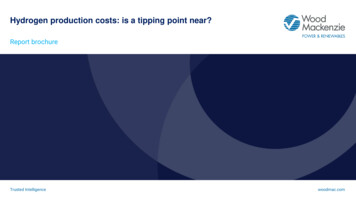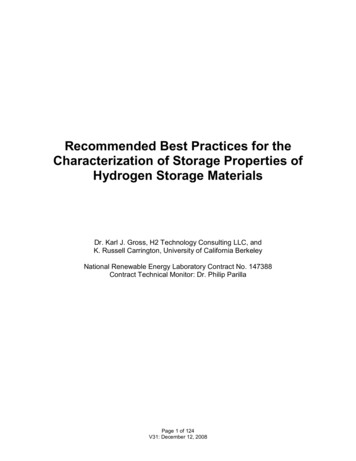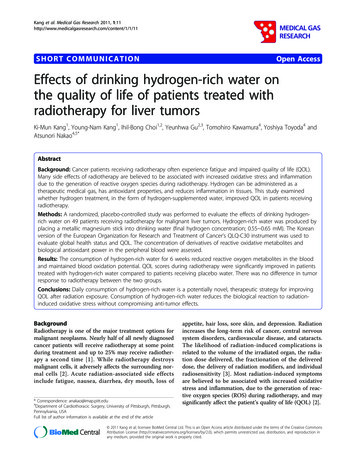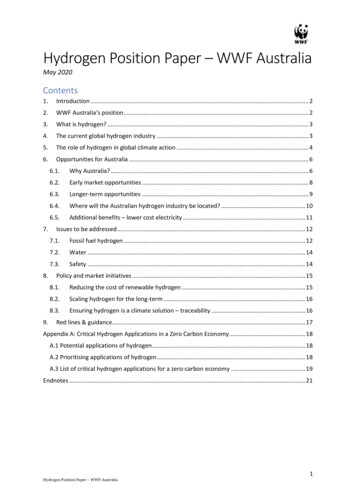
Transcription
Hydrogen Position Paper – WWF AustraliaMay 2020Contents1.Introduction . 22.WWF Australia’s position . 23.What is hydrogen? . 34.The current global hydrogen industry . 35.The role of hydrogen in global climate action . 46.Opportunities for Australia . 67.8.9.6.1.Why Australia? . 66.2.Early market opportunities . 86.3.Longer-term opportunities . 96.4.Where will the Australian hydrogen industry be located? . 106.5.Additional benefits – lower cost electricity . 11Issues to be addressed . 127.1.Fossil fuel hydrogen . 127.2.Water . 147.3.Safety . 14Policy and market initiatives . 158.1.Reducing the cost of renewable hydrogen . 158.2.Scaling hydrogen for the long-term . 168.3.Ensuring hydrogen is a climate solution – traceability . 16Red lines & guidance . 17Appendix A: Critical Hydrogen Applications in a Zero Carbon Economy . 18A.1 Potential applications of hydrogen. 18A.2 Prioritising applications of hydrogen . 18A.3 List of critical hydrogen applications for a zero-carbon economy . 19Endnotes . 211Hydrogen Position Paper – WWF-Australia
1. IntroductionIn 2019 WWF Australia launched its Renewable Powerhouse Campaign seeking to make Australia theworld’s leading renewable exporter by 2030. The generation of cost competitive renewablehydrogen is critical to several of Australia’s renewable export pathways including: The direct export of renewable hydrogen,The creation and export of derivative chemical products such as ammonia, andThe manufacture and export of green steel and green cement.As with all potential renewable exports, it is essential that Australia also benefit domestically and bygrowing domestic applications of renewable hydrogen to develop expertise in ‘learning by doing’ sowe can in turn create cost competitive export capabilities.In November 2019, the Council of Australian Governments (COAG) Energy Council endorsed aNational Hydrogen Strategy. However, there is a lot of hype about hydrogen, some of it iswarranted, some of it is not.This document sets out WWF Australia’s position on hydrogen, the opportunities, issues andrequired interventions in advocating for this critical industry. This will be the first in a series ofpapers outlining WWFs positions on the multiple renewable export opportunities arising from aplanned renewable exports program.2. WWF Australia’s positionWWF-Australia believes renewable hydrogen is essential to the full decarbonisation of the globaleconomy and ought to be supported subject to:1. Being renewable only. Renewable hydrogen is the only hydrogen production method that iszero carbon. Hydrogen from coal and gas contribute to dangerous climate change and are adistraction from establishing new renewable hydrogen-based industries essential to the fulldecarbonisation of the global economy.2. Being traceable. If we are to ensure that only renewable hydrogen is supported, it isessential that guarantee of origin schemes be put in place.3. Stringent public, worker and environmental safety practices being adopted. Hydrogen ishighly combustible and in many cases its derivatives are toxic; as such, it is essential thatsafety measures be instituted through the supply chain.4. Being developed in accordance with sustainability principles. Renewable hydrogen and theassociated infrastructure, like all forms of energy production, are not free fromenvironmental or social impacts. Efforts must be taken to reduce negative environmentaland social externalities and maximising the biodiversity and social co-benefits associatedwith hydrogen project and industry development.5. Being pursued as a complementary strategy to electrification. For many applications andsectors directly powering them with renewable electricity is the easier, more efficient, andcost-effective pathway to decarbonisation than renewable hydrogen. However, Australiacurrently lags much of the OECD in pursuing electrification. It is essential that the pursuit ofhydrogen is not used as a delay tactic or comes at the expense of electrificationopportunities.6. The industry being structured so as to lower energy costs to Australian consumers. In thepast the pursuit of fossil fuel energy export industries has happened at the expense of2Hydrogen Position Paper – WWF-Australia
Australian consumers; WWF wants to ensure that the development of a renewablehydrogen industry benefits Australians.3. What is hydrogen?Hydrogen is the smallest molecule in the universe and is the most common chemical element. Whilenot naturally occurring on its own on Earth, it can be produced as a gas. When hydrogen gas isburnt, it burns cleanly, producing only water vapour and no greenhouse gas emissions.Renewable hydrogen is produced when renewable electricity powers an electrolyser which splitswater molecules into its constituent parts – hydrogen and oxygen. The renewable hydrogen is thencaptured and used for a range of applications.Figure 1: How is renewable hydrogen made? (Source: Renewable Hydrogen 2017)Hydrogen can be produced using a number of other chemical processes, including steam reformingof methane and gasification of coal; both of these processes produce greenhouse gas emissions.Hydrogen can be thought of like electricity - it doesn't occur naturally on Earth, it has to be createdand just like electricity it can be made in ways that are highly polluting or it can be made in ways thatare zero carbon. As such, like electricity, hydrogen is not inherently polluting or clean – it dependsprimarily on how it is made.4. The current global hydrogen industryWhile hydrogen is being touted as a new opportunity, the reality is that the hydrogen industry isalready a large and important global industry and, unfortunately, a highly carbon polluting industry.Currently, 99% of global hydrogen is produced from fossil gas and coal and accounts forapproximately one percent of global greenhouse gas emissionsi– see Hydrogen is currently used as afundamental building block in the chemical industry for the manufacture of ammonia and methanol.3Hydrogen Position Paper – WWF-Australia
Ammonia is one of the world’s most globally traded commodities and is used to make fertilizers thatare essential to global agriculture and food production.Figure 2.Hydrogen is currently used as a fundamental building block in the chemical industry for themanufacture of ammonia and methanol. Ammonia is one of the world’s most globally tradedcommodities and is used to make fertilizers that are essential to global agriculture and foodproduction.Figure 2: 2017 CO2 emission by country and sector (Mt CO2 /year) (Source: Wood Mackenzie, 2019)Refineries, where hydrogen is used for the processing of intermediate oil products, are another areaof use.ii Table 1 outlines what current hydrogen production globally and in Australia is used for. TheInternational Energy Agency (IEA) estimates current global hydrogen production is 70millon tonnesper annum.iiiTable 1: Global and Australian uses of hydrogen (Source: Hydrogen Europe, 2019 and ANT Energy Solutions, 2020)Hydrogen UseGlobal PercentageAustralian PercentageAmmonia Synthesis55%65%Refineries25%33%Methanol Production10%0%Other10% 1%According to chemical company Incitec Pivot,iv Australia produces 550,000 to 600,000 tonnes ofhydrogen per annum, more than 98% of which is used in the chemical industry for oil refining and toproduce explosives and fertilizers. All of Australia’s current hydrogen production is made via steamreforming of methane which is an emissions-intensive process.4Hydrogen Position Paper – WWF-Australia
5. The role of hydrogen in global climate actionCurrently, the world is at 1 degree of warming and impacts from bushfires, to droughts, to floods aredevastating to both human life and the precious ecosystems on which life depends.The climate science says that the world must achieve net zero emissions of greenhouse gases before2050 if the world hopes to stay below 2 degrees of global heating and must decarbonise even morerapidly to stay below 1.5 degrees.In order to achieve net zero emissions there must be zero emissions options and technologies for allsectors of the economy. Historically, however, there are several economic sectors that are bothemissions-intensive and have been considered “hard to decarbonise.” These sectors include themanufacture of steel, aluminium and cement, the chemical industry, shipping, and other heavytransport.These sectors are considered hard to decarbonise because they cannot easily be directly powered,or their emissions removed using renewable electricity by electrification or fuel-switching.Recent research has found that the creation of a global renewable hydrogen industry presents thebiggest opportunity to decarbonise all of these “hard to decarbonise” sectors. Indeed, research anddevelopment is currently underway to create hydrogen alternatives to fossil fuels in all thesesectors.Figure 3: Potential demand for hydrogen in different scenarios, 2050 (Source: BNEF, 2020)Renewable hydrogen may also play a role in providing seasonal storage and peaking power to theelectricity sector and some role in other transport and heating applications where direct5Hydrogen Position Paper – WWF-Australia
electrification is not possible. See Appendix A for a full list of critical hydrogen applications for globaldecarbonisation.A recent report by Bloomberg New Energy Financev found that if the world is to keep warming tobelow 1.5 degrees, renewable hydrogen will be needed to meet between 7% (under the weak policyscenario in Figure 3) and 24% of global energy needs by 2050 (under the strong policy scenario inFigure 3). This percentage could be higher if all the ‘unlikely to electrify’ sectors in the economysubstitute fossil fuels with renewable hydrogen (theoretical maximum scenario in Figure 3).Under the strong policy scenario (middle column in Figure 3), an additional 11TWs of wind and solarcapacity will also be required just for hydrogen production over the next 30 years, to generate31,320TWh. To put this in perspective, this is more electricity than is currently generated globallyfrom all sources for all applications. If we are to unlock this opportunity, BNEF projects US 11trillion in hydrogen production, storage and transport infrastructure investment will be required.Australia is not the only country to have understood both the need and opportunity for renewablehydrogen as Figure 4 shows.Figure 4: Global Hydrogen Agenda 2017-January 2019 (Source: Queensland Government, 2019)1 vi6. Opportunities for Australia6.1. Why Australia?Few places in the world are as well endowed with the resources needed to position themselves as aglobal leader in renewable hydrogen as Australia. Australia has a large land area and some of the1This image highlights some recent hydrogen policies or policy positions both in Australia and globally, it isnot an exhaustive list.6Hydrogen Position Paper – WWF-Australia
best solar and wind resources in the world, and world’s fourth largest capital market more thancapable of cost-effectively funding this infrastructure development at the scale required. Throughwater recycling and desalination of sea water we have abundant water resources.We have expertise, trust, a stable democracy and strong existing trade relationships. This means thatAustralia has the potential to produce some of the cheapest renewable hydrogen in the world (seeFigure 5).Figure 5: Estimated delivered renewable hydrogen costs to large-scale industrial users in 2030 (left) & 2050 (right) (Source:BNEF, 2020)Meanwhile, some of our biggest trading partners such as Japan, South Korea, Singapore and evencountries in Europe face significant challenges decarbonizing their energy sectors (see Figure 6).They have higher populations, less land, and a lot less sunshine. BNEF concludes that a number ofplaces around the world will not have enough wind and/or solar resources to produce sufficientrenewable electricity for direct domestic use in the power, transport and industry sectors, while alsohaving enough renewable capacity to produce hydrogen for the remaining applications.Figure 6: Indicative estimate of the ability for major countries to generate 50% of electricity and 100% of hydrogen fromwind and solar PV in a 1.5 degree scenario (Source: BNEF, 2020)vii7Hydrogen Position Paper – WWF-Australia
As such, Australia has the opportunity to capture a significant share of what BNEF projects couldbecome a 700 billion per year global industry, sufficient to offset the inevitable technology drivenprogressive decline in our LNG (A 49 billion in 2019/20) and thermal coal exports (A 21 billionviii).By aggressively developing a renewable hydrogen industry, we can help our neighbours and keytrading partners decarbonise, while underpinning the economic competitiveness of Australia’smanufacturing, resources, and agricultural sectors in a low-carbon world. We can also useAustralia’s abundant renewable resources and cost-competitive renewable hydrogen to attractingnew industries to the Australian economy.6.2. Early market opportunitiesWhile there are many possible markets for renewable hydrogen, WWF-Australia believes thefollowing three represent the greatest short-term opportunities or “use-cases” for Australia to growdomestic demand for renewable hydrogen, and in the process create a cost-competitive renewablehydrogen sector, positioning ourselves as a global leader in this emerging green industry.Decarbonising the fertilizer industryThe global fertilizer industry is currently the largest end-user of hydrogen. Hydrogen is used tocreate ammonia – a nitrogen-rich chemical, which in turn is used to make nitrogen-based fertilizers.Unlike some potential applications for renewable hydrogen, where the technology is not yetcommercial, because the fertilizer industry already relies on hydrogen production at scale, it is arelatively simple process to progressively replace fossil-fuel based hydrogen with renewablehydrogen to create ammonia.Around the world and across Australia we are seeing many feasibility studies and renewableammonia pilot projects for the fertilizer industry, including in Queensland and Western Australia.While one of Australia’s seven ammonia facilities supplies approximately 5% of the global market,Australia is actually a net importer of ammonia. As such, by investing in renewable ammonia8Hydrogen Position Paper – WWF-Australia
production and the creation of a renewable fertilizer industry, Australia could go from net importerto net exporter of ammonia and fertilizer and help decarbonise this global industry in the process.ANT Energy Solutions (2020) agrees, identifying the replacement of current hydrogen productionparticularly for ammonia with renewable hydrogen as the greatest hydrogen market opportunity inAustralia by scale between 2020-2025. Ammonia is far more stable and compact than hydrogen,making export transportation significantly more cost-competitive today.Heavy Vehicle TransportConversations with investors investigating hydrogen opportunities in Australia suggests thatrenewable hydrogen production in places with excellent wind and solar resources is likely to be costcompetitive or nearly cost-competitive with expensive imported diesel for trucks at remote minesites. Indeed, Aurecon Australasiaix recommends focusing on back-to-base transport fleets andtransitioning bulk handling in the mining and heavy industry sectors for early investment inhydrogen for transport.Already, Anglo American are developing a hybrid mining dump truck powered by both electricity andhydrogen fuel, which will be tested at their mining operations in South Africa towards the end of2020.x Meanwhile Bosch, Kenworth/Toyota and a Canadian consortium AZETEC (Alberta ZeroEmissions Truck Electrification Collaboration) are all working on long-range fuel cell electric trucks tobe powered with hydrogen.Given that Australian fuel consumption, including diesel, is highly reliant on importsxi, and the factthat Australia has high quality renewable resources and many remote mines and communities, thereis an opportunity to increase energy security by growing a commercial renewable hydrogen truckingindustry in Australia, starting with mining trucks. In the longer-term, hydrogen fuel cells for longhaul trucks represent a significant market opportunity.It should be noted that WWF does not see the same opportunity for hydrogen fuel cell passengerand light vehicles in Australia, as the evidence suggests that electric vehicles are a more efficient andcost-effective zero-carbon solution being deployed at a rapidly increasing scale today (see AppendixA).Gas injectionInjecting renewable hydrogen directly into the gas grid is another area where we are seeing asignificant number of pilot projects globally and in Australia, including in South Australia and NSW.Injecting renewable hydrogen into the gas grid has the potential to create both early demand atscale for renewable hydrogen, and also build broad industry experience in creating and usinghydrogen.However, there are limits to this application. Depending on the age of the gas infrastructure and thematerials it is made of, the limits to injecting hydrogen into the existing gas infrastructure rangefrom 5-20%, with most industry experts suggesting 10% is the average limit. Beyond these limits,both the gas grid and end-use equipment (stoves in households to gas boilers) will require significantupgrades and often wholesale replacement.It is likely, that in many domestic and industry applications, directly converting to renewableelectricity (electrify/fuel switch) rather than upgrade to renewable hydrogen will be a more costeffective way to decarbonise. Indeed, analysis by Renew found that it was much more cost-effectivefor new homes to go all-electric with solar, rather than connecting to the gas grid. Indeed, the9Hydrogen Position Paper – WWF-Australia
savings are above 10,000 per household over ten years.xii Meanwhile, Beyond Zero Emissions hasidentified electrification options for almost all industrial uses of gas, particularly many low andmedium temperature industry processes.xiiiThere are concerns that a renewable hydrogen gas injection strategy will be used to extend the lifeof the gas industry and justify opening new gas reserves. As such, WWF only supports renewablehydrogen gas injection if jurisdictions are also pursuing renewable electrification strategies forhouseholds, commercial buildings, and industry.6.3. Longer-term opportunitiesSome of the largest renewable hydrogen opportunities are in sectors where hydrogen applicationsare still in the research, development, and early deployment stages. However, if Australia wants toensure it captures these likely future hydrogen markets, it is essential that it is involved in the earlystages of the industries development, given the global technology race that is already wellunderway. Of the many potential applications for renewable hydrogen WWF-Australia has currentlyidentified the following three as the most promising use-cases for an Australian domestic and exporthydrogen industry.Green building materialsSteel, aluminium and cement are critical materials for the construction of most buildings andinfrastructure globally. Manufacturing of steel and cement represents about 14% of globalemissions. In Australia, we are globally significant exporters of iron ore (37% of global production)and bauxite (28% of global production) - the raw materials used to manufacture steel andaluminium.xiv We also produce steel, cement, and aluminium domestically.The use of renewable hydrogen as both a heat source and reductant has been identified as the mostpromising decarbonisation pathway for these difficult-to-decarbonise industries. These threesectors represent significant economic opportunities for Australia. For example, the EnergyTransition Hub found that by converting just 18% of the iron ore that Australia exports annually intogreen steel, using renewable hydrogen, would almost double Australia’s current iron ore and steelexport revenue.xv Further, the Grattan Institute has found that value-adding our domestic resourceindustries and creating a new green steel industry in Central Queensland and the Hunter Valleycould replace the coal mining jobs in these regions.xviInternationally, we are seeing renewable hydrogen pilot projects, particularly in the steel industry inEurope, but Australia is yet to follow suit, though the Liberty Steel Group project in Whyalla could bethe first example.xvii If Australia wants to capture a significant global share of the renewablehydrogen industry for green building materials, it is important that Australia invests in research anddevelopment to modernise our steel, cement, and aluminium industries. It is also important to growlocal demand for zero carbon building materials domestically.Decarbonising shippingGreen ammonia presents one of the most promising pathways to decarbonise the deep-oceanshipping industry. If Australia pursues the development of a green ammonia industry, we will bewell placed to help supply the global shipping industry. However, to position Australia as a greenammonia supply country of choice, it will be important to play a role in shipping demonstrationprojects fuelled by green ammonia. It will also be important to develop strategic bilateralcollaborations with countries like Singapore, which are currently global shipping and oil bunkeringhubs, and work with the International Maritime Organization.10Hydrogen Position Paper – WWF-Australia
Exporting to other countriesWhile producing goods and commodities with renewable hydrogen onshore is likely to be a greatermedium-term opportunity for Australia, several of our key trading partners have flagged theintention to import renewable hydrogen or ammonia from Australia.However, BNEF warns that shipping hydrogen is the least efficient or cost-effective approach torenewable hydrogen distribution (well behind direct use locally and pipes). Nevertheless, they agreethat due to renewable resource availability in import countries as well as geopolitical considerations,some renewable hydrogen is likely to be shipped globally. As such, continuing to build strategic bilateral and multi-lateral agreements and partnerships with likely renewable hydrogen import nationssuch as Japan, Singapore and South Korea will be critical, particularly as they are already key energytrade partners for Australia.6.4. Where will the Australian hydrogen industry be located?Australia’s existing hydrogen industry is located in coastal, urban industrial centres such asGladstone, Newcastle and Kwinana in Perth. Early indications suggest that these locations and othersimilar industrial centres such as Bell Bay in Tasmania and Whyalla in South Australia are likely to bethe main locations for renewable hydrogen production in Australia. However, given that Australia’sbest renewable resources are inland, this will require additional investment in transmissioninfrastructure.One opportunity would be to use renewable hydrogen pilot projects and hubs to help foster broaderrenewable industry precincts, which could jointly benefit from the infrastructure required to servicemultiple low-carbon industries, including: Transmission lines to transport renewable electricity for direct industrial use and hydrogenproduction,Hydrogen pipelines,Water infrastructure for hydrogen production (see Section 7.2),A port where both hydrogen and other green commodities can be exported, andA skilled workforce.6.5. Additional benefits – lower cost electricityAs Australia moves to ever higher penetrations of renewable energy, particularly solar and wind,there will be an increase in periods when electricity supply could exceed demand. This phenomenonis called the “duck-curve.” One solution to the duck-curve is “flexible demand” – these areelectricity-using processes that can turn on when electricity prices are low and there is excessgeneration, and turn off when prices are high. If incentivised correctly, for example throughtargeted tariffs, electrolyzers creating renewable hydrogen could be an excellent use for this excesselectricity generation. According to Wood Mackenzie, electrolyzers “used for green hydrogenproduction can operate dynamically, requiring only seconds to be able to operate at maximumcapacity. As such, they can be easily paired with renewable assets that are frequently curtailed foreither a long or short duration.”xviiiIncentivising electrolysers to act flexibly on-demand would in turn enable “overbuilding” ofrenewables and the long overdue grid modernisation investments now required. Analysis byClimateWorks suggests that taking an over-building renewable energy to 200% capacity – double11Hydrogen Position Paper – WWF-Australia
what the country currently needs – “could be more cost-effective than building to 100%, and wouldspark new clean export opportunities”,xix such as hydrogen.In addition, this increased demand for electricity could help cover more of the fixed costs oftransmission and other electricity system upgrades, lowering network and system costs for allelectricity users.xxThis co-benefit is an example of ‘sector coupling’ whereby building shared infrastructure andallowing optimization not just within sectors, but across sectors, lowers the cost of decarbonizationfor all sectors. That is, the hydrogen production that, for example, is needed by the steel sectorhelps lower the cost of renewable energy integration for the power sector.However, if incentivised inefficiently, electrolyser use could drive up electricity demand at peaktimes, exacerbating the duck-curve and driving up electricity prices for consumers. This would betantamount to prioritising export hydrogen customers over domestic energy customers, which iswhat has occurred in the LNG industry on the east coast and should be avoided at all costs.7. Issues to be addressedRenewable energy and other zero-emissions technology solutions including renewable hydrogen areclearly solutions to climate change, helping countries and industries move away from carbonpolluting alternatives. However, that does not mean these technologies and associatedinfrastructure come without other environmental and social impacts. It is essential that as wetransition to clean energy, new clean industries including hydrogen are developed sustainably, withall efforts taken to reduce or eliminate negative environmental, social, health and safety impacts andexternalities. Indeed, opportunities for co-benefits and net-positive sustainability outcomes shouldbe actively pursued.In relation to hydrogen, there are three major issues that WWF-Australia believe must urgently beaddressed that are outlined in more detail below.7.1. Fossil fuel hydrogenCurrently, the fossil fuel industry is promoting hydrogen from fossil gas and coal, both with andwithout carbon capture and storage (CCS) technology. Their argument is that it is important toestablish a fossil hydrogen industry now, on the basis that a renewable hydrogen industry willdevelop later.As the Australia Institute argues “this approach is likely to lock in high carbon infrastructure andundermine the green hydrogen opportunity. For example, hydrogen made from fossil fuel methodsand electrolysis use different processes and require different infrastructure. Furthermore, fossil fuelbased hydrogen requires proximity to fossil fuel sources and carbon storage sites where renewablehydrogen requires proximity to water and renewable energy sources”.xxiFrom a carbon pol
National Hydrogen Strategy. However, there is a lot of hype about hydrogen, some of it is warranted, some of it is not. This document sets out WWF Australia's position on hydrogen, the opportunities, issues and required interventions in advocating for this critical industry. This will be the first in a series of

